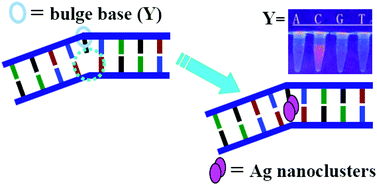Specific recognition of DNA bulge sites by in situ grown fluorescent Ag nanoclusters with high selectivity†
Abstract
There is much demand for the development of reliable methods of bulge site recognition in DNA in order to find disease-related mutations and identify bulge sequence environments. Herein, we found that the bulge site in the DNA duplex can be used to selectively grow fluorescent silver nanoclusters (Ag NCs). The as-prepared Ag NCs exhibit an emission behavior dependent on the base environment near the bulge site and can be employed in situ as a readout for specific bulge site recognition. Fluorescent signal-on sensing for the bulge site based on this inorganic fluorophore is substantially advantageous over the organic fluorophores previously used as probes, in which a fluorescent signal-off response was usually observed with context guanines flanking the bulge site. The strong dependence of the fluorescent Ag NCs’ formation on the bases surrounding the bulge site is successfully used to identify the bulge environment near the codon 177 of cancer suppression gene p53. We expect that bulge site-determined Ag NC formation is very likely to be developed into a simple method for bulge site recognition with high selectivity and sensitivity.


 Please wait while we load your content...
Please wait while we load your content...